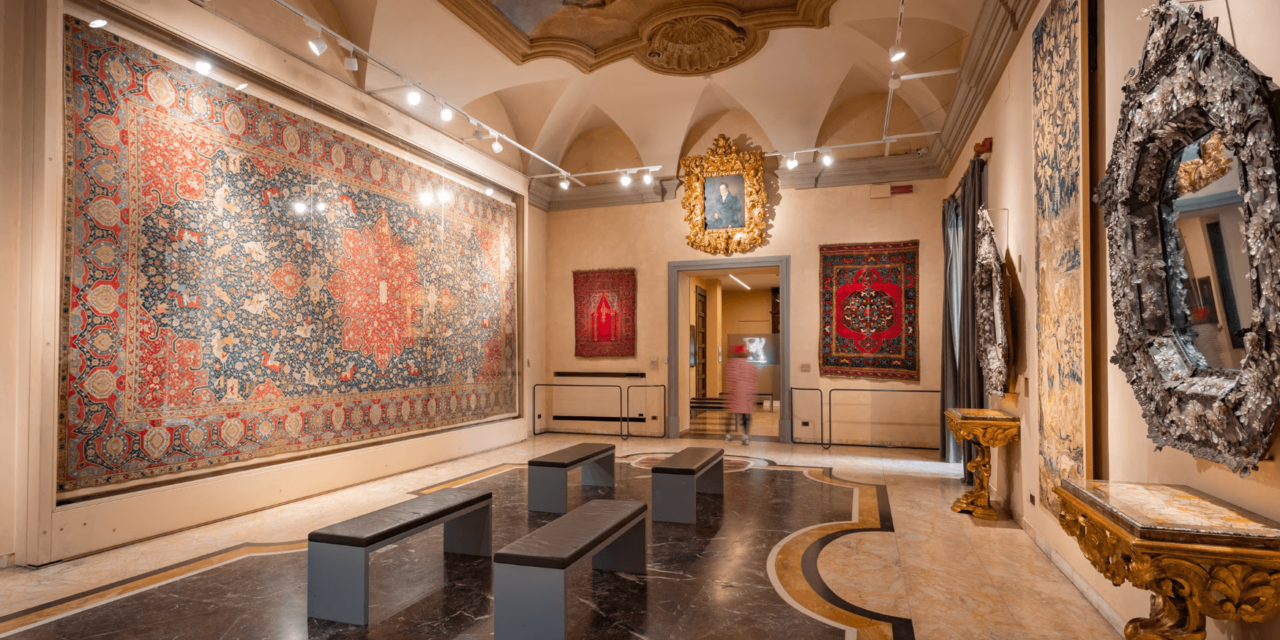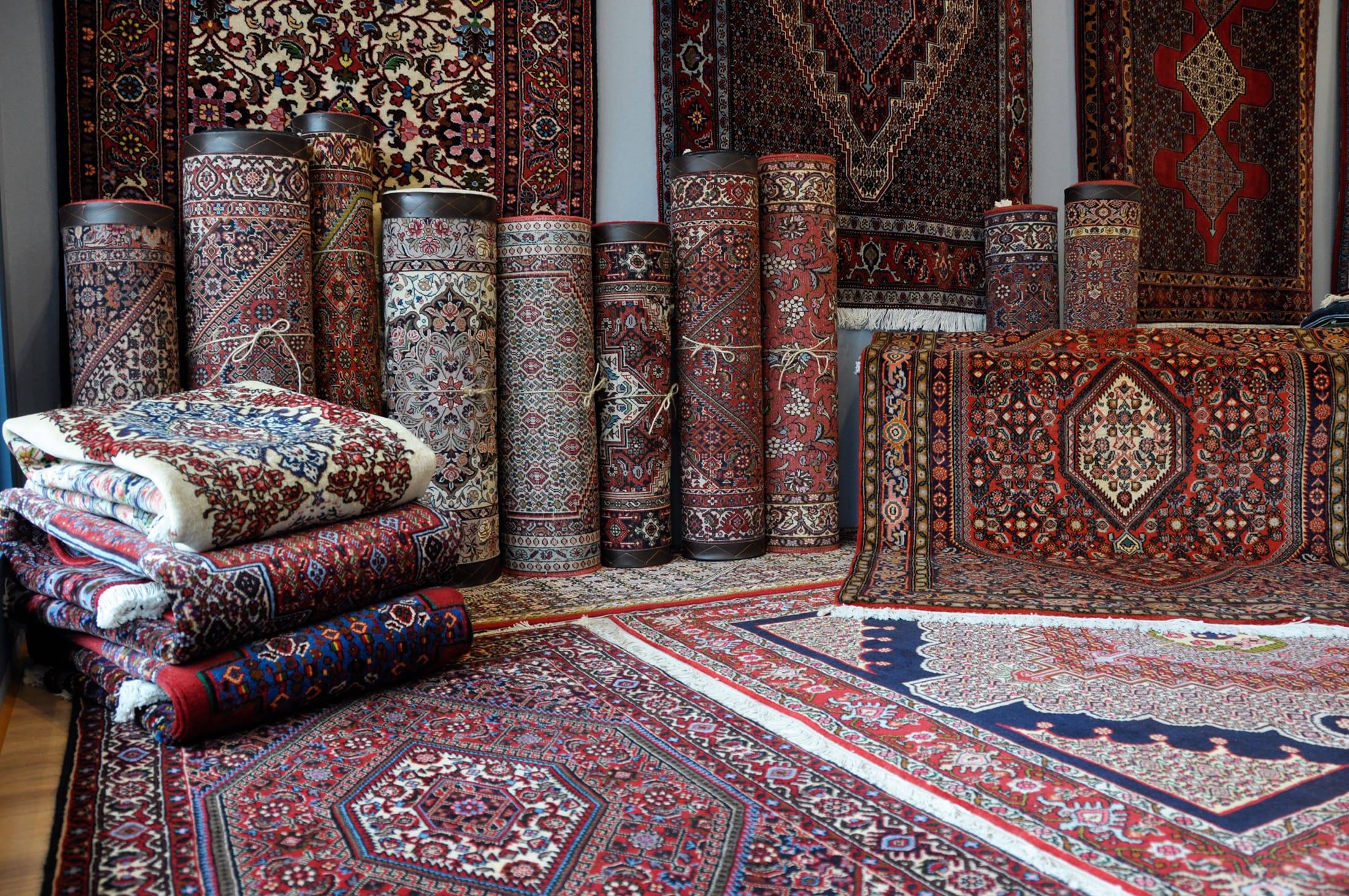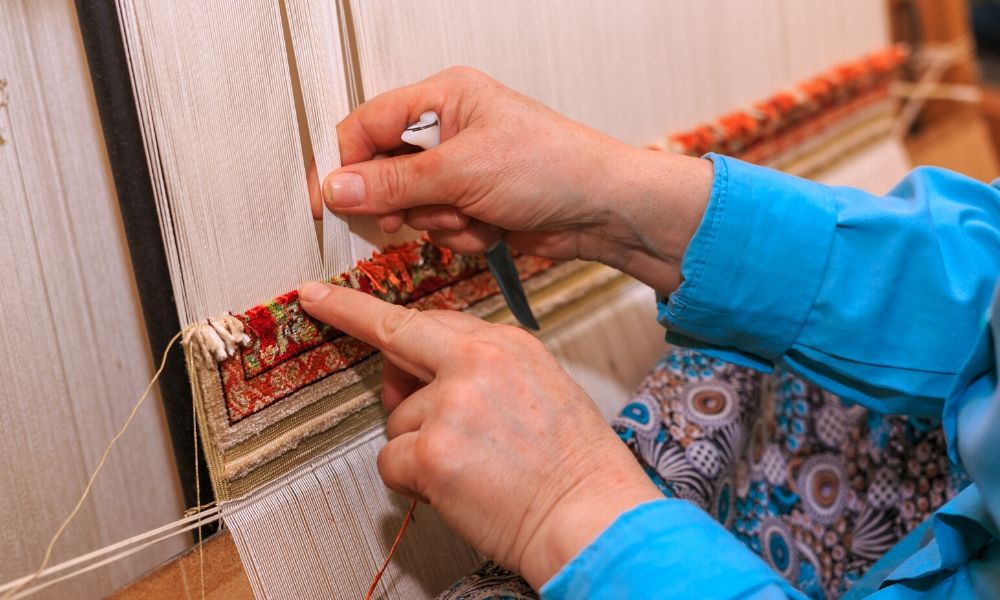Carpet is a thick piece of fabric used to cover the floor. It is made by two mediums hand and machine, using wool, cotton, synthetic material, or other fibers. In older times, the word “carpet” also meant cloth used on tables or walls, but now it mostly means a floor cover. Some carpets cover the whole floor, while others only cover a small part. People often use the word “rug” for smaller ones.
Carpets are made by hand or machine. A handmade carpet takes months, sometimes years, using threads tied together knot by knot. These are made from wool, cotton, silk, or mixed fibers. Machine carpets are faster to make and cost less. Handmade ones last longer and have more care in them. The look and feel depend on the threads, knots, and designs used.
Handmade Carpets
Handmade carpets are also referred as hand-knotted or handwoven carpets as they are created without machines, using hand techniques. Each and every knot is tied by hand, which makes the process slow but detailed. These carpets are mostly made from natural fibers like wool, cotton, and silk, and the work can take several weeks to even half of years, depending on size and knot density. Regions like Persia (now Iran), India, Turkey, and Pakistan have been known for this craft for over 2,000 years. Many handmade carpets carry traditional patterns, family symbols, or meanings woven into them. Some older pieces from the 17th and 18th centuries are now kept in museums for their historical value.
Machine-made Carpets
Machine-made or machine produced carpets are made quickly in large quantity using machines that weave or tuft the fibers automatically. Most use synthetic materials like nylon, polyester, or polypropylene, which are cheaper and more stain-resistant than natural fibers. While they don’t carry the same cultural depth, they provide easy access to designs and sizes that suit modern homes. A machine-made carpet that takes minutes to produce might copy a handmade pattern that took months to finish. These carpets became popular especially after the 1950s, as demand for affordable home décor grew.
Dyes and Coloring
Before modern factories, carpets were always colored using natural dyes. Artificial dyes came from plants like madder, indigo, sumac, and woad, or from small insects and sea animals. Craftsmen also added minerals like alum to help the color stay in the threads for a long time. Most natural dyes were gentle on the fibers and created soft, colors that aged beautifully. One unique feature was “abrash,” where colors slightly change across the carpet this wasn’t a mistake, but a natural result of hand-dyeing, and it made each carpet feel alive and full of character. In the mid-1800s, people started using man-made dyes, called aniline dyes. These were faster and brighter, but often looked too sharp and didn’t last well over time. By the late 19th century, many carpet makers went back to natural dyes. Today, both natural and improved synthetic dyes are used, but many weavers still choose natural ones for their shades, long life, and for the sense of tradition.
Structure and Material
Most carpets throughout history have been made using sheep wool. It is strong, soft, easy to work with, and accepts dyes well. Other animal hairs like camel and goat are used less often due to their rough or dull texture. Cotton, though not ideal for pile because of its flat look, is very useful for the base or structure of a carpet. In many Eastern countries, cotton is used for the warp, which are the vertical threads stretched on the loom before weaving begins. Silk, while expensive, is known for producing very fine and detailed carpets. In past centuries, especially the 1500s and 1600s, some Persian carpets were made entirely of silk. Though silk was rarely used for knotting in European rugs, it sometimes appeared in the weft or in decorative parts of tapestries. Other plant fibers like linen, hemp, and jute have also been used for the foundation of carpets, depending on the region and period. Jute became common in factory-made carpets starting in the 1800s.
The most known and widely loved type of carpet is the knotted-pile carpet. In these, the top surface is formed by tying short strands of yarn around two vertical threads (warp), then locking the row with a horizontal yarn (weft). This technique creates a thick, cushioned surface called pile. The tighter and more even the knots, the clearer and more detailed the design. When enough knots are tied, they are pushed down firmly using a heavy comb, and then the top is cut level. The height of the pile varies formal or palace rugs often have short piles, while tribal or nomadic rugs can have taller ones, sometimes up to an inch. Over time, weavers across regions developed different ways to tie the pile yarns, which affects the look and strength of the carpet.
Three main types of knots are used. The symmetrical knot, often called the Turkish knot, is found in carpets from Turkey, the Caucasus, and parts of Iran and Europe. The asymmetrical knot, or Persian knot, is common in Iran, India, Egypt, and China. A third, much rarer type known as the Spanish knot loops around a single warp thread and was mainly used in Spain before becoming uncommon in later centuries. The tighter the knots and the finer the threads, the more detailed the patterns. Some simple carpets have as few as 20 knots per square inch, while others, like high-end Indian rugs, may have over 2,000.
Metal threads are sometimes woven into carpets to create shiny details, especially in decorative or ceremonial pieces. Gold or silver-coated yarns can highlight parts of the design and reflect light in a way that adds depth. But these threads wear down quickly and lose their shine over time, which makes them better for wall display or special uses than everyday floor use.
Not all carpets are knotted. Some are flat-woven, meaning they have no pile. These include kilims and soumaks. Kilims are made by interweaving the warp and weft yarns in a flat pattern. When two colors meet in kilims, they don’t blend — instead, small gaps form where the colors change, which becomes part of the design. Soumak rugs use a wrapping technique, where colored yarns wrap over and under the foundation in rows, creating a slightly raised, textured surface. This gives a clear, often slanted line pattern, like a herringbone effect.
Another type, though rare, is the embroidered carpet. These are more common in Europe and North America, where designs are stitched onto a strong fabric backing using threads. Some Turkish and Indian carpets use chain stitch over felt or cloth bases. Traditional needlepoint styles like cross-stitch or petit point can cover the full surface of a rug. However, due to the delicate surface, embroidered carpets are more often used as decoration rather than for walking.
Motifs
Carpet designs across the world have used three main types of motifs: geometric, stylized, and naturalistic. The geometric style is the oldest and simplest. It includes repeated shapes like crosses, stars, diamonds, and straight waves. One of the oldest shapes used in borders is the “meander” or “Greek key,” a winding line with sharp turns. Triangle shapes, stars based on eight points, and the swastika (a symbol far older than its 20th-century misuse) were also common. These patterns were easy to make in early crafts like basket weaving and later passed into rug designs. Many of these motifs remain strong in carpets from Turkey, Iran, Central Asia, and the Caucasus.
The stylized motifs in carpets are more flowing and decorative. One well-known design is the arabesque, which means curved lines and scrolls forming flowers and vines. This style came to Persia in the 1100s but began in China over 2,000 years ago, first seen on bronze mirrors and pottery. A common shape was two vine-like lines crossing and curling outward to form a flower, then joining other lines to create a repeating pattern. Two famous designs from China that influenced carpets were the cloud knot and cloud band, used since the Han dynasty (206 BCE–220 CE). These designs reached Persia by the 1500s and appeared in Turkish court rugs after the Ottomans expanded their empire. These flowing patterns made the carpets look elegant, with a strong sense of movement and life.
Another large group of stylized motifs is the palmette, based on palm tree shapes. Palmettes have many forms, but they often link back to the palm tree, lotus flower, pomegranate, and grapevine—all symbols of life, growth, and abundance. The lotus is tied to water and fertility, while the vine symbol points to long life and nature’s power. These shapes first showed up in Assyrian art and moved into carpets around the 4th century. Over time, they blended with Chinese art to form more soft, rounded designs, especially in Persia during the 1500s and 1600s. Peony flowers, with full, soft petals, also entered Persian designs during this period, while tulips appeared in Ottoman Turkish court rugs.
Naturalistic motifs in carpets often show real trees and flowers. Cypresses, fruit trees in bloom, and willows appear in Persian rugs to suggest peace, rebirth, and eternal life. In some famous Persian carpets from the time of Shah Abbas (late 1500s), trees and flowers are drawn with much detail. Flowers like jasmine and tulips were also shown. In Europe, red and pink roses became popular around the 1500s and later made their way into Persian designs during the 1800s.
In illustrative carpets, the focus shifts to people, animals, and garden scenes. These carpets often tell small stories or reflect daily life. Persian rugs may show birds like nightingales or pheasants, a bird borrowed from Chinese art. Larger animals such as lions, tigers, deer, and cheetahs appear in hunting scenes. Hunters on horses are common, as are musicians and angels. In border areas, fish are sometimes shown in water or paired like shields. Chinese dragons and the qi-lin, a gentle horse-like figure, were also included in carpets traded between China and the Islamic world.
Symbolism
Carpets from the East often carry deep symbolic meanings, not just through single motifs but through the entire design. In many cases, the whole carpet becomes a symbol, expressing beliefs, power, and cultural values. One of the earliest and most powerful examples of this comes from ancient Persia: the Spring Carpet of Khosrow, also known as the Winter Carpet, made during the 6th century for the grand palace of the Sāsānid king at Ctesiphon, near what is now Baghdad.
Although the actual carpet was lost long ago, historical writings describe its beauty and meaning. It was designed to look like a royal garden: with flowing water channels, flowerbeds, blooming trees, and walking paths. Instead of using ordinary materials, artists crafted this masterpiece with silk, gold, pearls, and precious stones. Yellow pebbles were shown using gold threads. The flowers, fruits, and birds were shaped with pearls and colorful gems. The edge of the carpet was decorated with emeralds, symbolizing green grass and a fresh meadow. This enormous carpet was said to be about 84 feet (25.6 meters) wide on each side, and when sunlight entered the palace and touched its surface, the entire room must have glowed with color and light.
But this carpet is stood for the king’s divine duty to guide nature, control the seasons, and ensure that spring would return. In a spiritual sense, it also symbolized heaven, or the Garden of Paradise. The Persian word for paradise originally meant “a walled garden,” and that idea was deeply rooted in Persian culture. With flowing water, blossoms, birds, and trees, the carpet showed a world far beyond the desert one full of life, joy, and eternal peace.
This garden carpet deeply inspired Persian culture. Even centuries later, artists, poets, and weavers kept its memory alive. While no other carpet could fully copy its richness, the idea behind it continued. The vision of paradise a peaceful garden with birds, flowers, and water became a theme in many Oriental rugs. These designs tried to show a perfect world: scenes with animals playing, hunters riding through forests, lakes with ducks, or skies filled with spiritual figures. In some rugs, jinn, angels, or blessed people appear, joining a scene of celebration or peace. Sometimes, verses are woven into the rug, praising its beauty or calling it a garden of joy. These carpets are more than art they are a dream of paradise, a reminder of nature, peace, and eternal life.
Usage
Carpets have been used in Central and Western Asia for thousands of years, mainly to cover hard-packed earth floors. They were found in every kind of space from tents and homes to mosques and palaces. In rich Eastern households, carpets were not just for comfort or warmth; they also added beauty and style to the room. Often, people arranged several carpets together in a specific pattern for both display and practical use.
In traditional settings, there are usually four main carpets in a room:
The largest one, called mīān farsh, is laid in the center. It’s usually about 18 by 8 feet (5.5 by 2.5 meters).
Two long runners, known as kanārehs, are placed on each side of the main carpet. They’re around 18 by 3 feet (5.5 by 1 meter) and mostly used as walking paths.
At one end of this setup, a principal rug called a kellegi is placed across the width. It usually measures about 12 by 6 feet (3.7 by 1.8 meters).
This setup is not just about filling space. It reflects tradition, balance, and purpose, with each rug playing its own role in the layout.
Prayer Carpets:
Some carpets are specially made for religious use. The prayer rug, or namāzlik, is one example. Its design usually features a mihrab a niche-like shape pointing toward Mecca, just like the prayer niche found in a mosque wall. These rugs may also include symbols like hanging lamps, water jugs, or handprints, marking where the worshipper stands and prays.
Decorative Rugs:
When Asian carpets first arrived in Europe, especially before the mid-1600s, people treated them as luxury objects too valuable to walk on. They were brought out only for special church days or to honor important guests. Most of the time, these carpets were hung on walls or used to cover tables, furniture, or balconies during festivals, especially in Italy.
Summary
A carpet is a thick, woven textile used mainly as a floor covering, traditionally handmade or machine-made. Originating in Central and Western Asia, early carpets served practical, decorative, and symbolic roles. Handmade carpets use wool, silk, or cotton with knotted pile construction for durability and artistic design. Motifs often carry cultural or religious meanings, including geometric, floral, and pictorial patterns. Carpets range from prayer rugs to massive palace pieces, historically valued as art, gifts, dowries, and symbols of status. Today, carpets remain vital in interiors, heritage, and global trade.






